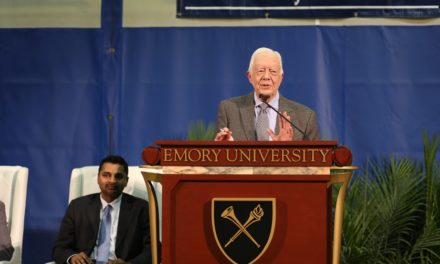The Class of 2025 welcomed 769 new members to Emory University on Dec. 9 through the first round of Early Decision applications. Even amid public health and economic complications brought on by the COVID-19 pandemic, the University received 1,975 early decision applications, an 8% increase from last year.
The College admitted 614 students and Oxford College admitted 337 students, with 182 students admitted to both.
Dean of Admissions John Latting said Emory’s admissions team was prepared for the unique challenges of assessing this year’s applicant pool.
“We actually spent a lot of time in our training process getting ready for the reading period and being prepared for anything,” he said. “There may be applicants that for the spring of junior year don’t have grades, have pass-fail grading or no test scores.”

Emory Admissions Building./ (Matthew Friedman, Contributing)
To account for any discrepancies, Emory provided additional space on its application for students to share any COVID-19 related challenges they faced. They also allowed teachers, counselors and school administrators to submit a similar addendum.
“What we are always trying to do is make our selection … about the person and the student behind the application,” Latting said.
Emory admissions’ most notable change this year was its adoption of a test-optional policy, which waived SAT and ACT test scores. Students were not penalized for withholding their scores, but those who chose to report them held a slight advantage, Latting noted.
“More admitted students do have scores,” Latting said. “Still, a little under 40% of our admitted students don’t have test scores. That’s a lower percentage than in the applicant pool as a whole.”
Latting admitted he was surprised at how many students did not submit scores — this development sparked conversations among the admissions team as to whether or not Emory should make the test-optional policy permanent.
“It’s eye-opening to us how big a deal that is, how much students think about that and how hard they prepare for that,” Latting said. “To not have that be a requirement is making a big difference. We’ve got a lot of thinking to do about what’s the right policy for Emory.”
Latting also pointed out that this year’s Early Decision I applicant pool comprised a significantly larger portion of minority groups than in previous years. Socioeconomic diversity increased as well, he said, as there was a rise in the number of students applying for financial aid. One such marker of this trend was Emory’s matching with 56 QuestBridge Scholars, over twice that of last year.
Despite substantial jumps in the number of students taking leaves of absence and deferrals this semester, Latting said his team had no plans to limit the number of accepted applicants in the Early Decision I round.
“We’re obviously not taking down our offers of admission, at least so far, because we have more deferrals,” Latting said. “We’re trying to be fair to this current applicant pool. We’ll see how that plays out in Regular Decision.”
Overall, Latting said he feels encouraged that, despite the University’s inability to host typical information sessions and school visits, the applicant pool grew and diversified.
“The theme is the stability of Emory’s place in the minds of really good students around the country and around the world. That’s holding firm and that’s really great to see,” Latting said.
Emory will undergo two more rounds of acceptance for the Class of 2025. Applicants who applied through Early Decision II will be notified of their status by Feb. 15 and Regular Decision applicants will receive their admission offers by April 1.
Ulia (she/her) (24C) is from northern Virginia, studying Spanish & Portuguese. She also writes for the Wheel's news section and Emory In Via, Emory's Christian academic journal. Additionally, Ahn is involved in campus residence life and likes to bake in her free time.





